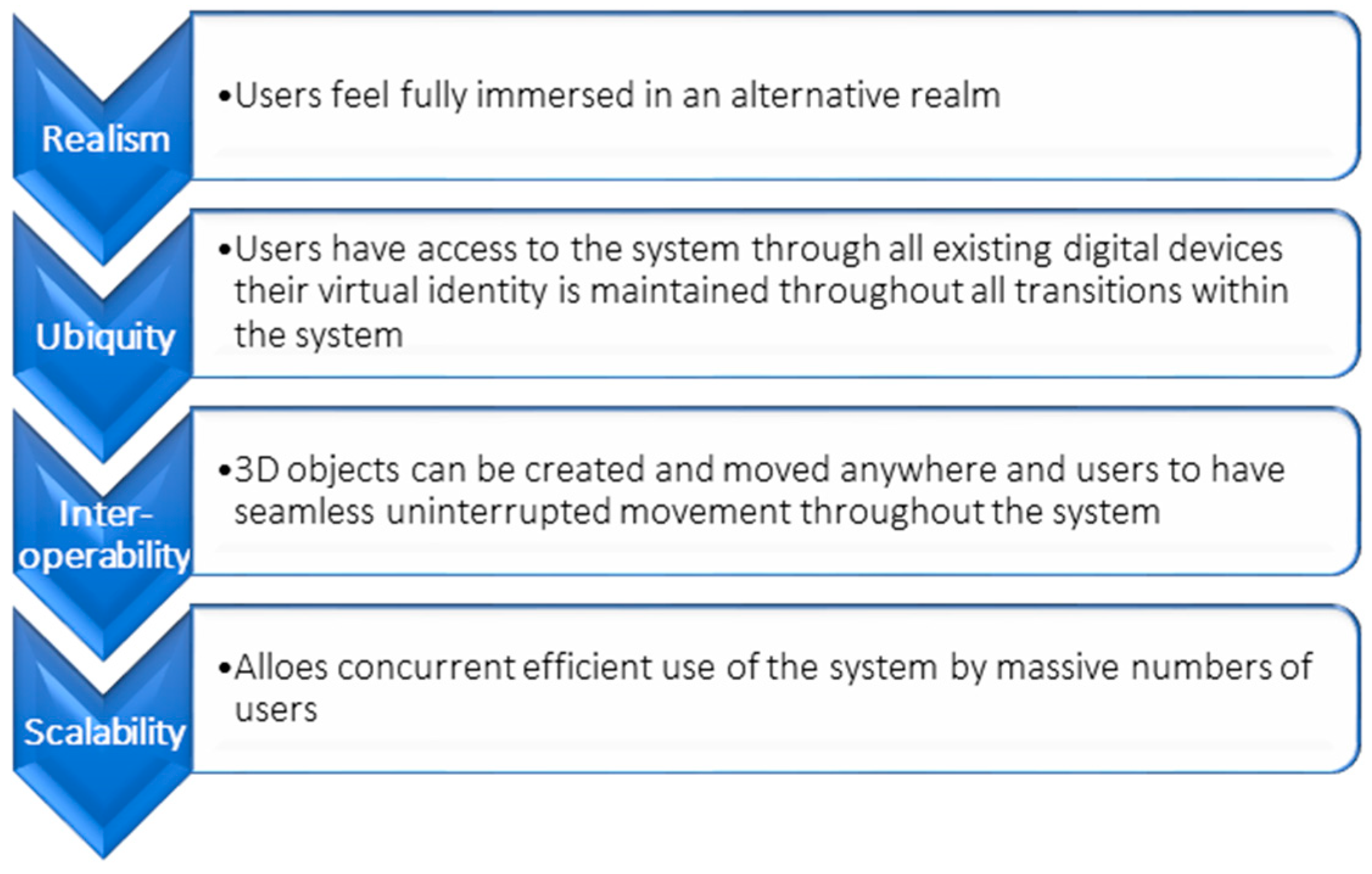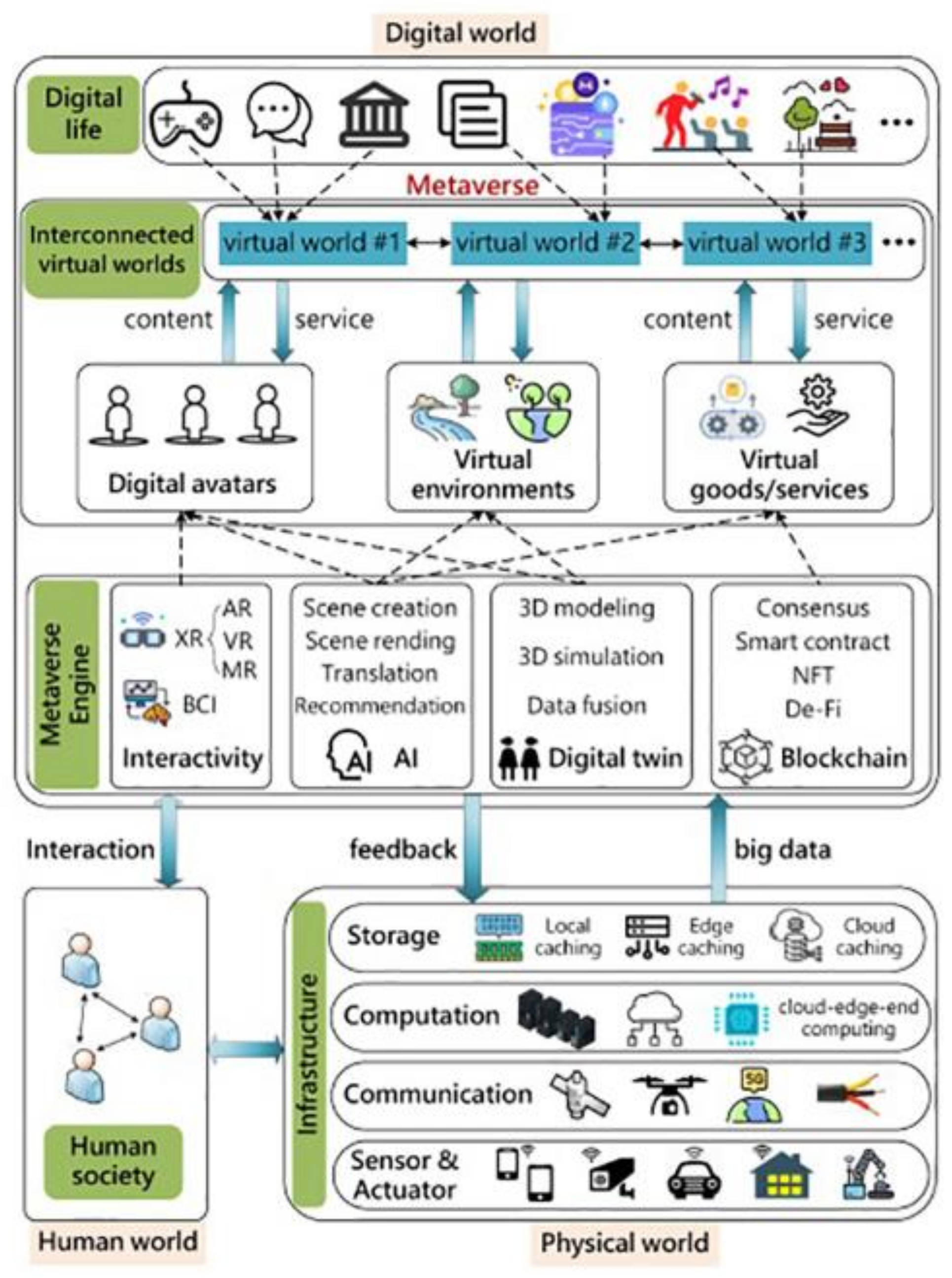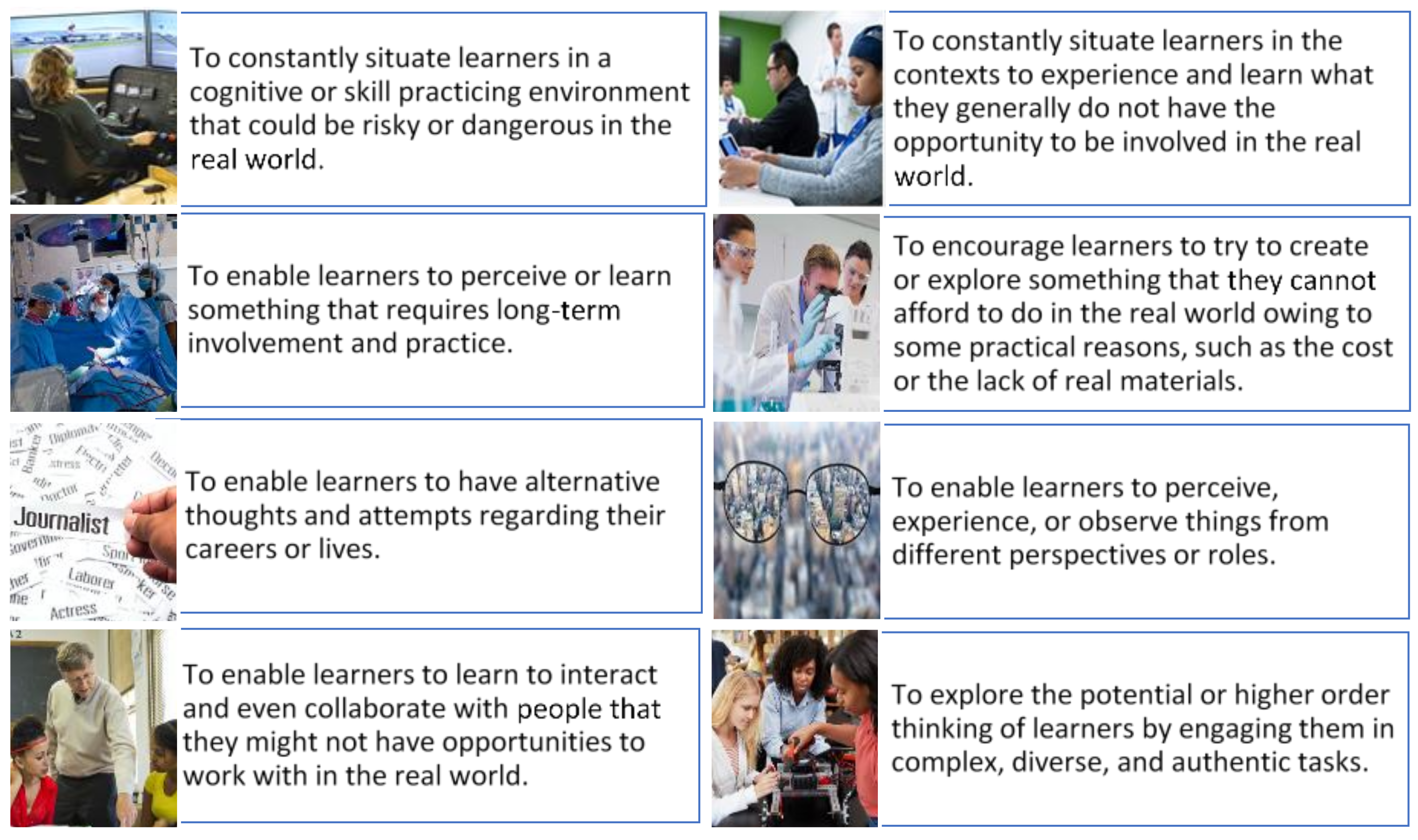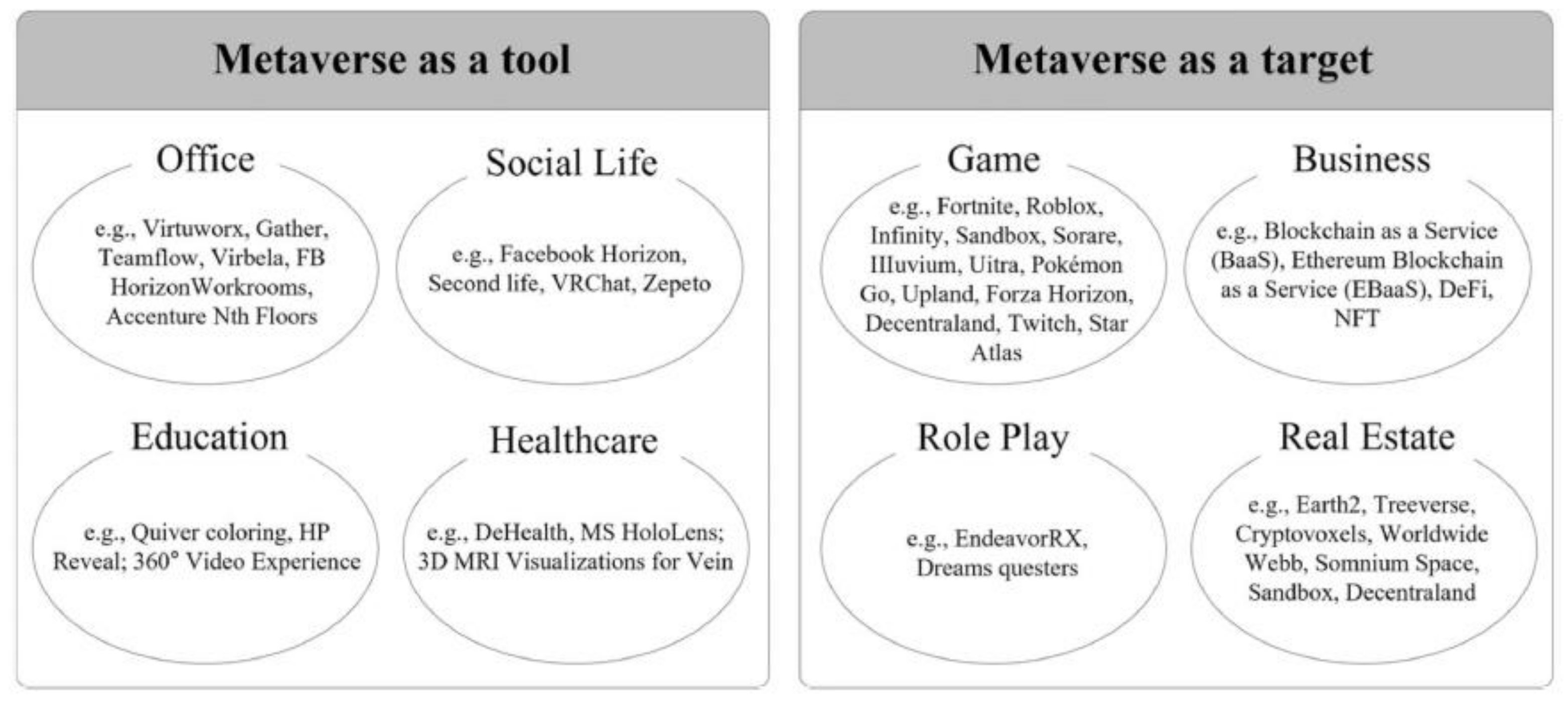Metaverse as a Learning Environment: Some Considerations
Abstract
1. Introduction
2. Materials and Methods
3. The Metaverse and Digital Society
4. The Metaverse and Education
5. Changes in Education
- 1.
- To assist the experiments that could be risky, irreversible, or toxic in the real world, e.g., an experiment with a potential risk of explosion;
- 2.
- To assist the experiment conditions and scientific phenomena that could not be possible in the real world, e.g., an experiment that needs to be carried out in a vacuum;
- 3.
- To assist the experiments that need relatively high costs and funds in the real world, e.g., an experiment that needs expensive equipment and materials;
- 4.
- To assist the experiments that react slowly or need long-term observations and records in the real world, e.g., an experiment needs learners to observe and record the whole growth stage of an insect.
[…] there are two forms of teachers and peers that learners can interact with: one is avatar teachers and peers, and another is intelligent NPC teachers and peers. On one hand, through interaction with teachers and peers in the form of avatars or intelligent NPCs, learners can get more emotional support and real-time feedback instead of just looking at a grid of faces or boring slides on video-conferencing platforms. On the other hand, intelligent NPC teachers and peers can help to implement learning activities and give personalized support during class or after class. Social constructivism has emphasized that an individual’s knowledge is constructed through social interactions […]; hence, it could be a reason for using the metaverse in education for the cognitive and social development of learners [16] (pp. 7 and 9).
6. Challenges
The learning analysis module aims to utilize massive data to analyze and display learners’ learning performances and achievements by unit or in all. More significantly, it can make assessing learners’ performance easier, and provide teachers with reliable proof to conduct personalized services for learners [16] (p. 7).
- i.
- There is no high-level design or systematic planning and explicit development goals in terms of implementing the metaverse in education;
- ii.
- There is a lack of theoretical and applied research in the field of the edu-metaverse, i.e., the educational products used in the edu-metaverse environment are not sufficiently based on systematic and scientific theoretical support in the educational field.
- iii.
- There is a risk of ethical issues arising from the use of the edu-metaverse, as data as information about individuals is easily accessible and is used for unethical purposes. On the other hand, the sources of data and information are increasingly complex, which may lead to issues of trust on the part of users. In addition, and perhaps most importantly, the edu-metaverse is highly immersive and interactive, which can present a real risk of addiction for students.
- iv.
- There is a risk of capital manipulation, inasmuch that under the general consideration that the edu-metaverse can reduce the existing education gap, it is critical to analyze whether capital can be the edu-metaverse and thus impede educational equity and perpetuate the digital divide [47].
7. Conclusions
[…] first, teachers should carefully analyze how students understand the metaverse; second, teachers should design classes for students to solve problems or perform projects cooperatively and creatively; third, educational metaverse platforms should be developed that prevent misuse of student data [11] (p. 1).
Author Contributions
Funding
Institutional Review Board Statement
Informed Consent Statement
Data Availability Statement
Conflicts of Interest
References
- Morais, G.; Santos, V.; Gonçalves, C. Netnography: Origins, foundations, evolution and axiological and methodological developments and trends. Qual. Rep. 2020, 25, 441–455. [Google Scholar] [CrossRef]
- Sá, M.J.; Santos, A.I.; Serpa, S.; Ferreira, C.M. Digital literacy in digital society 5.0: Some challenges. Acad. J. Interdiscip. Stud. 2021, 10, 1–9. [Google Scholar] [CrossRef]
- Ferreira, C.M.; Serpa, S. Society 5.0 and social development: Contributions to a discussion. Manag. Organ. Stud. 2018, 5, 26–31. [Google Scholar] [CrossRef]
- Serpa, S.; Ferreira, C.M. Sustainability and digital as challenges of sociology. J. Educ. Soc. Res. 2020, 10, 15–23. [Google Scholar] [CrossRef]
- Gambetti, R.C.; Kozinets, R. Agentic netnography. New Trends Qual. Res. 2022, 10, e519. [Google Scholar]
- Addeo, F.; Delli Paoli, A.; Esposito, M.; Ylenia Bolcato, M. Doing social research on online communities: The benefits of netnography. Athens J. Soc. Sci. 2019, 7, 9–38. [Google Scholar] [CrossRef]
- Kozinets, R.V.; Scaraboto, D.; Parmentier, M.-A. Evolving netnography: How brand auto-netnography, a netnographic sensibility, and more-than-human netnography can transform your research. J. Mark. Manag. 2018, 34, 231–242. [Google Scholar] [CrossRef]
- Lugosi, P.; Quinton, S. More-than-human netnography. J. Mark. Manag. 2018, 34, 287–313. [Google Scholar] [CrossRef]
- Hutson, J. Social virtual reality: Neurodivergence and Inclusivity in the metaverse. Societies 2022, 12, 102. [Google Scholar] [CrossRef]
- Mistretta, S. The metaverse—An alternative education space. AI Comput. Sci. Robot. Technol. 2022, 1–23. Available online: https://www.intechopen.com/journals/1/articles/87 (accessed on 5 September 2022). [CrossRef]
- Kye, B.; Han, N.; Kim, E.; Park, Y.; Jo, S. Educational applications of metaverse: Possibilities and limitations. J. Educ. Eval. Health Prof. 2021, 18, 32. [Google Scholar] [CrossRef]
- Sá, M.J.; Serpa, S. The COVID-19 pandemic as an opportunity to foster the sustainable development of teaching in higher education. Sustainability 2020, 12, 8525. [Google Scholar] [CrossRef]
- Abbate, S.; Centobelli, P.; Cerchione, R.; Oropallo, E.; Riccio, E. A First Bibliometric Literature Review on Metaverse. In Proceedings of the 2022 IEEE Technology and Engineering Management Conference (TEMSCON EUROPE), Izmir, Turkey, 25–29 April 2022; pp. 254–260. [Google Scholar]
- Suh, W.; Ahn, S. Utilizing the metaverse for learner-centered constructivist education in the post-pandemic era: An analysis of elementary school students. J. Intell. 2022, 10, 17. [Google Scholar] [CrossRef]
- Cui, H.; Xu, Z.; Yao, C. Will the Metaverse be the Future of the Internet? In Proceedings of the 2022 8th International Conference on Humanities and Social Science Research (ICHSSR 2022), Chongqing, China, 22–24 April 2022; pp. 2165–2170. [Google Scholar]
- Zhang, X.; Chen, Y.; Hu, L.; Wang, Y. The metaverse in education: Definition, framework, features, potential applications, challenges, and future research topics. Front. Psychol. 2022, 13, 1016300. [Google Scholar] [CrossRef]
- Knox, J. The metaverse, or the serious business of tech frontiers. Postdigit. Sci. Educ. 2022, 4, 207–215. [Google Scholar] [CrossRef]
- Illenberger, R. The Metaverse Paradox: Why the Industry Needs Standardization. 11 July 2022. Available online: https://www.weforum.org/agenda/2022/07/the-metaverse-paradox-why-we-need-standardization/ (accessed on 3 September 2022).
- Damar, M. Metaverse shape of your life for future: A bibliometric snapshot. J. Metaverse 2021, 1, 1–8. Available online: https://journalmetaverse.org/index.php/jm/article/view/article1 (accessed on 7 September 2022).
- Krotoski, A. A Beginner’s Guide to the Metaverse: What It Is, How You Can Access It and More. BBC Science Focus Magazine 2022. 12 July 2022. Available online: https://www.sciencefocus.com/future-technology/metaverse/ (accessed on 3 September 2022).
- Mustafa, B. Analyzing education based on metaverse technology. Technium Soc. Sci. J. 2022, 32, 278–295. [Google Scholar] [CrossRef]
- Floridi, L. Metaverse: A matter of eXperience. Philos. Technol. 2022. Available online: https://papers.ssrn.com/sol3/papers.cfm?abstract_id=4121411 (accessed on 6 September 2022).
- Lim, W.Y.B.; Xiong, Z.; Niyato, D.; Cao, X.; Miao, C.; Sun, S.; Yang, Q. Realizing the metaverse with edge intelligence: A match made in heaven. arXiv 2022, arXiv:2201.01634. Available online: https://arxiv.org/abs/2201.01634 (accessed on 5 September 2022).
- Tlili, A.; Huang, R.; Shehata, B.; Liu, D.; Hosny, A.; Metwally, S.; Wang, H.; Denden, M.; Bozkurt, A.; Lee, L.-H.; et al. Is metaverse in education a blessing or a curse: A combined content and bibliometric analysis. Smart Learn. Environ. 2022, 9, 24. [Google Scholar] [CrossRef]
- Allam, Z.; Sharifi, A.; Bibri, S.E.; Jones, D.S.; Krogstie, J. The metaverse as a virtual form of smart cities: Opportunities and challenges for environmental, economic, and social sustainability in urban futures. Smart Cities 2022, 5, 771–801. [Google Scholar] [CrossRef]
- Dionisio, J.D.N.; Burns, W.G., III; Gilbert, R. 3D virtual worlds and the metaverse: Current status and future possibilities. ACM Comput. Surv. 2013, 45, 1–38. [Google Scholar] [CrossRef]
- Bardin, L. L’Analyse de Contenu, 2nd ed.; Content Analysis; PUF: Paris, France, 2013. [Google Scholar]
- Mayring, P. Qualitative Content Analysis: Theoretical Foundation, Basic Procedures and Software Solution; GESIS: Klagenfurt, Austria, 2014. [Google Scholar]
- Krippendorff, K. Content Analysis: An Introduction to Its Methodology, 4th ed.; Sage Publications: Thousand Oaks, CA, USA, 2018. [Google Scholar]
- Quivy, R.; Campenhaudt, L.V. Manual de Investigação em Ciências Sociais, 4th ed.; Handbook of Research in Social Sciences; Gradiva: Lisboa, Portugal, 2005. [Google Scholar]
- B-ON. What Is B-ON? Available online: https://www.b-on.pt/en/what-is-b-on/ (accessed on 3 September 2022).
- SCILIT. Available online: https://www.scilit.net/ (accessed on 5 September 2022).
- Song, Z. Interpersonal Communication Research in Metaverse. Taking Sci-Fi Films as Examples. In Proceedings of the 2022 8th International Conference on Humanities and Social Science Research (ICHSSR 2022), Chongqing, China, 22–24 April 2022; pp. 2377–2382. [Google Scholar]
- Vernaza, A.; Armuelles, V.I.; Ruiz, I. Towards an Open and Interoperable Virtual Learning Environment Using Metaverse at University of Panama. In Proceedings of the 2012 Technologies Applied to Electronics Teaching (TAEE), Vigo, Spain, 13–15 June 2012; pp. 320–325. [Google Scholar]
- Jiaxin, L.; Gongjing, G. Socializing in The Metaverse: The Innovation and Challenge of Interpersonal Communication. In Proceedings of the 2022 8th International Conference on Humanities and Social Science Research (ICHSSR 2022), Chongqing, China, 22–24 April 2022; pp. 2128–2131. [Google Scholar]
- Kahla, K.B. University, Multiversity, Technoversity and Metaversity. Should the Old Institution Be Buried? Presented at the Symposium “Is There a Tunisian University?” Tunis, Tunisia. 13 March 2021. Available online: https://papers.ssrn.com/sol3/papers.cfm?abstract_id=4077965 (accessed on 9 September 2022).
- Yue, K. Breaking Down the Barrier Between Teachers and Students by Using Metaverse Technology in Education: Based on a Survey and Analysis of Shenzhen City, China. In Proceedings of the 13th International Conference on E-Education, E-Business, E-Management, and E-Learning (IC4E 2022), Tokyo, Japan, 14–17 January 2022; pp. 40–44. [Google Scholar]
- Momtaz, P.P. Some very simple economics of Web3 and the metaverse. FinTech 2022, 1, 225–234. [Google Scholar] [CrossRef]
- Jaber, T.A. Security risks of the metaverse world. Int. J. Interact. Mob. Technol. 2022, 16, 4–14. [Google Scholar] [CrossRef]
- Giannini, T.; Bowen, J.P.; Michaels, C.; Smith, C.H. Digital Art and Identity Merging Human and Artificial Intelligence: Enter the Metaverse. In Proceedings of the EVA London 2022 (EVA 2022), London, UK, 4–8 July 2022. [Google Scholar]
- Hedrick, E.; Harper, M.; Oliver, E.; Hatch, D. Teaching & Learning in Virtual Reality: Metaverse Classroom Exploration. In Proceedings of the 2022 Intermountain Engineering, Technology and Computing (IETC), Orem, UT, USA, 14–15 May 2022; pp. 441–445. [Google Scholar]
- Serpa, S.; Ferreira, C.M. Goffman’s backstage revisited: Conceptual relevance in contemporary social interactions. Int. J. Soc. Sci. Stud. 2018, 6, 74–80. [Google Scholar] [CrossRef]
- Talan, T.; Kalınkara, Y. Students’ opinions about the educational use of the metaverse. Int. J. Technol. Educ. Sci. 2022, 6, 333–346. [Google Scholar] [CrossRef]
- Yong, Y.J.; Lee, J.H.; Kim, Y.S. A study on the possibility of a change in culture and arts education curriculum by shooting “METACLASSROOM” in the COVID19 pandemic era. Cypriot J. Educ. Sci. 2022, 17, 1603–1621. [Google Scholar]
- Sá, M.J.; Serpa, S. Transversal competences: Their importance and learning processes by higher education students. Educ. Sci. 2018, 8, 126. [Google Scholar] [CrossRef]
- Hwang, G.-J.; Chien, S.-Y. Definition, roles, and potential research issues of the metaverse in education: An artificial intelligence perspective. Comput. Educ. Artif. Intell. 2022, 3, 100082. [Google Scholar] [CrossRef]
- Wu, J.; Gao, G. Edu-metaverse: Internet Education Form with Fusion of Virtual and Reality. In Proceedings of the 2022 8th International Conference on Humanities and Social Science Research (ICHSSR 2022), Chongqing, China, 22–24 April 2022; pp. 1082–1085. [Google Scholar]
- Dwivedi, Y.K.; Hughes, L.; Baabdullah, A.M.; Ribeiro-Navarrete, S.; Giannakis, M.; Al-Debei, M.M.; Dennehy, D.; Metri, B.; Buhalis, D.; Cheung, C.M.K.; et al. Metaverse beyond the hype: Multidisciplinary perspectives on emerging challenges, opportunities, and agenda for research, practice and policy. Int. J. Inf. Manag. 2022, 66, 102542. [Google Scholar] [CrossRef]
- Wang, Y.; Li, L.-H.; Braud, T.; Hui, P. Re-shaping post-COVID-19 teaching and learning: A blueprint of virtual-physical blended classrooms in the metaverse era. arXiv 2022, arXiv:2203.09228v3. [Google Scholar]
- Warpefelt, H. The Non-Player Character. Exploring the Believability of NPC Presentation and Behavior; Stockholm University: Stockholm, Sweden, 2016. [Google Scholar]
- Benrimoh, D.; Chheda, F.; Margolese, H.C. The best predictor of the future: The metaverse, mental health, and lessons learned from current technologies. JMIR Prepr. 2022, 9, e40410. [Google Scholar] [CrossRef]
- Seigneur, J.-M.; Choukou, M.-A. How Should Metaverse Augment Humans with Disabilities? In Proceedings of the 13th Augmented Human International Conference (AH2022), Winnipeg, MB, Canada, 26–27 May 2022; pp. 1–6. [Google Scholar]
- Gülen, S.; Dönmez, İ.; İdin, Ş. STEM education in metaverse environment: Challenges and opportunities. J. STEAM Educ. 2022, 5, 100–103. [Google Scholar] [CrossRef]
- Ge, J. Multiple influences of intelligent technology on network behavior of college students in the metaverse age. J. Environ. Pub. Health 2022, 2022, 2750712. Available online: https://www.ncbi.nlm.nih.gov/pmc/articles/PMC9225902/ (accessed on 9 September 2022). [CrossRef]
- Cheong, B.C. Avatars in the metaverse: Potential legal issues and remedies. Int. Cybersecur. Law Rev. 2022, 3, 467–494. [Google Scholar] [CrossRef]
- Jagatheesaperumal, S.K.; Ahmad, K.; Al-Fuqaha, A.; Qadir, J. Advancing education through extended reality and internet of everything enabled metaverses: Applications, challenges, and open issues. arXiv 2022, arXiv:2207.01512. Available online: https://arxiv.org/pdf/2207.01512.pdf (accessed on 2 September 2022).
- Sá, M.J.; Santos, A.I.; Serpa, S.; Miguel Ferreira, C. Digitainability–Digital competences post-COVID-19 for a sustainable society. Sustainability 2021, 13, 9564. [Google Scholar] [CrossRef]
- Cooper, C.; Booth, A.; Varley-Campbell, J.; Britten, N.; Garside, R. Defining the process to literature searching in systematic reviews: A literature review of guidance and supporting studies. BMC Med. Res. Methodol. 2018, 18, 85. [Google Scholar] [CrossRef]




| Type of Document | Geographical Scope | Year of Publication | |||||
|---|---|---|---|---|---|---|---|
| Theoretical/ Conceptual | Empirical | International | National | 2022 | 2021 | 2020 | Prior to 2020 |
| 45 | 6 | 45 | 6 | 34 | 5 | 3 | 9 |
| Total: 51 publications | |||||||
| Categories | Defining traits |
|---|---|
| Infrastructure | The metaverse is a persistent virtual system with real-time information processing capabilities that can cause the current state of knowledge to be available to all users at the same time at all times. |
| Architecture | The metaverse is a decentralized platform that features a high degree of interoperability to enable the mobility of digital identities, experiences, and possessions across the metaverse from one place, event, or activity to another. |
| Human couth | The metaverse overcomes the limitations of Web 2.0-based virtual realities by enhancing users’ self-perception and presence, increasing human interactivity, and improving realistic expressions of human qualities, such as emotions. |
| Augmented Reality | Lifelogging | Mirror World | Virtual Reality | |
|---|---|---|---|---|
| Definition | Building a smart environment by utilizing location-based technologies and networks | Technology to capture, store, and share everyday experiences and information about objects and people | It reflects the real world as it is, but integrates and provides external environment information | A virtual world built with digital data |
| Features | Building a smart environment using location-based technology and networks | Recording information about objects and people using augmented technology | Virtual maps and modeling using GPS technology | Based on interaction activities between avatars that reflect the user’s ego |
| Applications | Smartphones and vehicle HUDs | Wearable devices and black boxes | Map-based services | Online multiplayer games |
| Use cases | Pokemon Go, Digital Textbook, and Realistic Content | Facebook, Instagram, Apple Watch, Samsung Health, and Nike Plus | Google Earth, Google Maps, Naver Maps, and Airbnb | Second Life, Minecraft, Roblox, and Zepeto |
| Type | Technical/Technological Characteristics | Educational Implications |
|---|---|---|
| Augmented reality |
|
|
|
| |
|
| |
| Lifelogging |
|
|
|
| |
|
| |
| ||
| Mirror world |
|
|
|
| |
|
| |
| Virtual reality |
|
|
|
| |
|
|
| Metaverse Characteristics | Merits | Shortcomings |
|---|---|---|
| New social communication space | Even in the case of school closures due to coronavirus disease 2019, students can socially connect beyond the limitations of reality | When forming a relationship with others, one forms a relationship centered on play that is weaker than interaction in the real world; privacy problems occur due to the collection and processing of various pieces of personal information |
| High degree of freedom | Expanding student autonomy in the learning process by providing experiences from content consumers to creators | Due to the high degree of freedom, platform administrators cannot predict all the actions of users and they can be exposed to various crimes due to the virtual space and anonymity of the metaverse |
| Through virtualization, high immersion | By providing a new experience that transcends time and space, it is possible to increase student interest and immersion to expand students’ active participation in learning | It can cause identity confusion, escape from reality, and maladaptation to the real world for students whose identity has not been established |
| Application | Challenges | Goal | Countermeasures |
|---|---|---|---|
| Healthcare education | Handling multi-modal medical data and streamlining | Innovative drive in medical education | New directions to the healthcare education sector could be driven through the integration of metaverse with AI, VR, AR, IoMT, Web 3.0, intelligent edge, cloud services, robotics, and quantum computing |
| Online education | Collaborative efforts and interactions | Immersive experience for teachers and students | Appropriate choice of XR and IoE equipment with dedicated seamless connectivity targeted for meeting the demands of the teachers and learners |
| Industrial training | Training robots and skill enhancement for labors | Monitor and control complex manufacturing units | Binding the hardware and software components of metaverse in the manufacturing, supply chain, design, development, and virtual warehousing to drive the market revenue and forecast the impact of technology over the next few years and make decisions accordingly |
| Aircraft maintenance training | Maintenance, status monitoring and control | Intuitive and efficient control of functional modules in aircraft | 3D twin models of aircrafts help to read the aircraft log books and records, which includes the entries of the condition of the internal equipment, status, and intimates the requirements for the learners and users in the remote place |
| Marine maintenance training | Handling of cybersecurity issues | Robust defense mechanisms against treats | Integration of metaverse with blockchain based technological trends, helps to reduce errors in maintenance tasks with secured means of handling the challenges with increased safety through alerts and notifications |
| Military training | Replicating the war scenes and dynamic adaptation | Trained to face adverse conditions | Improved productivity with clear instructions through metaverse driven equipment for dynamic handling of war situations |
| Art upskilling | Managing 3D virtual objects | Imagination and creativity to reality | Enhanced quality and accuracy with object recognition for immersive learning with applied creativity beyond the imagination |
| Gaming expertise | Integration of AI for provisioning immersive experiences | Collaborative learning | With unified and interoperable spaces rendered through the graphics, interaction with the people and objects in the virtual worlds causes the gaming platform to have incredible potential in using the metaverse for provisioning a diversified range of education, training, and skill development applications |
Disclaimer/Publisher’s Note: The statements, opinions and data contained in all publications are solely those of the individual author(s) and contributor(s) and not of MDPI and/or the editor(s). MDPI and/or the editor(s) disclaim responsibility for any injury to people or property resulting from any ideas, methods, instructions or products referred to in the content. |
© 2023 by the authors. Licensee MDPI, Basel, Switzerland. This article is an open access article distributed under the terms and conditions of the Creative Commons Attribution (CC BY) license (https://creativecommons.org/licenses/by/4.0/).
Share and Cite
Sá, M.J.; Serpa, S. Metaverse as a Learning Environment: Some Considerations. Sustainability 2023, 15, 2186. https://doi.org/10.3390/su15032186
Sá MJ, Serpa S. Metaverse as a Learning Environment: Some Considerations. Sustainability. 2023; 15(3):2186. https://doi.org/10.3390/su15032186
Chicago/Turabian StyleSá, Maria José, and Sandro Serpa. 2023. "Metaverse as a Learning Environment: Some Considerations" Sustainability 15, no. 3: 2186. https://doi.org/10.3390/su15032186
APA StyleSá, M. J., & Serpa, S. (2023). Metaverse as a Learning Environment: Some Considerations. Sustainability, 15(3), 2186. https://doi.org/10.3390/su15032186







